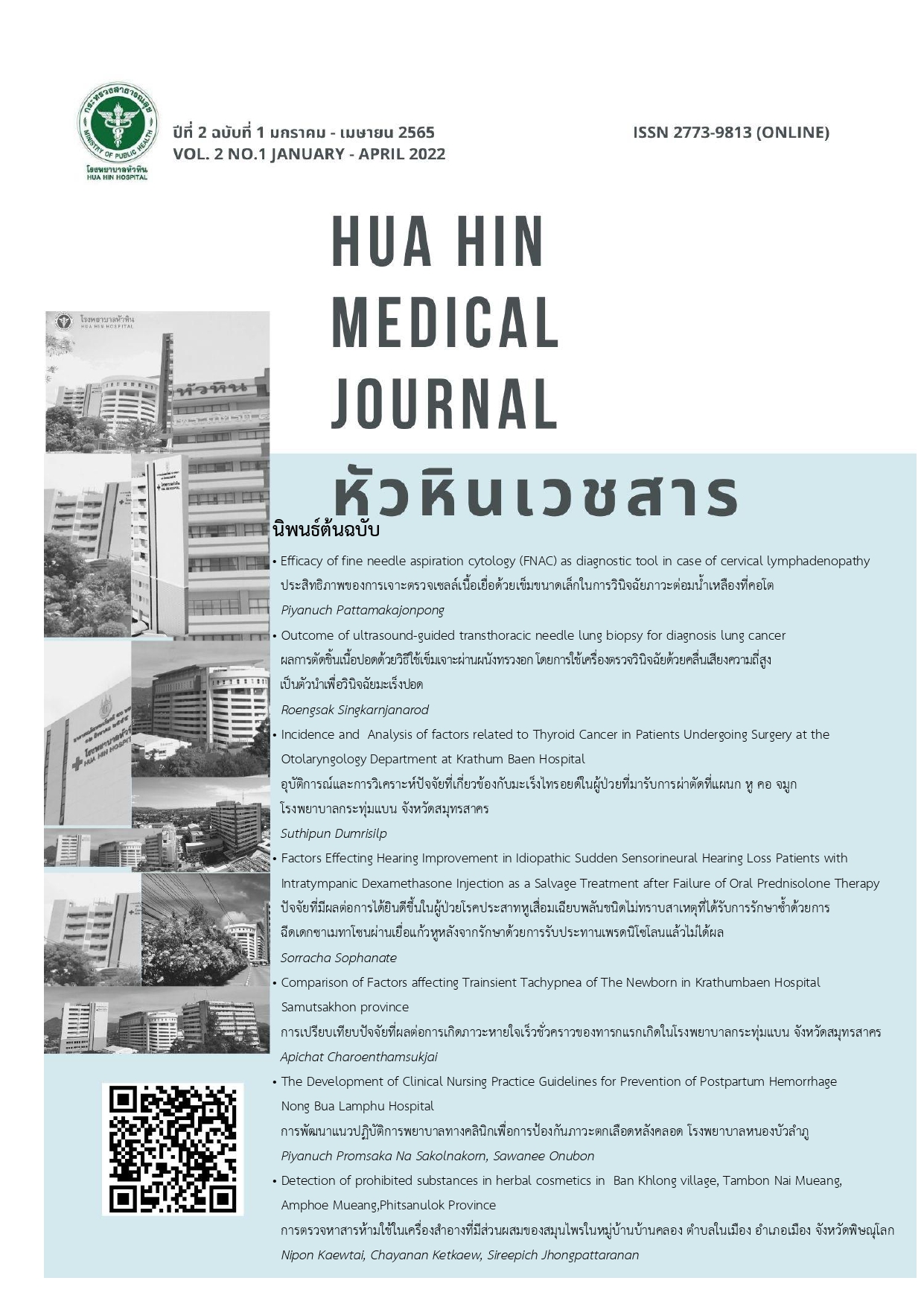The Development of Clinical Nursing Practice Guidelines for Prevention of Postpartum Hemorrhage Nong Bua Lamphu Hospital
Development of Clinical Nursing Practice Guidelines for prevention of postpartum hemorrhage Nong Bua Lamphu Hospital
Keywords:
Clinical Nursing Practice Guideline, Postpartum hemorrhage, PreventionAbstract
Background: Postpartum hemorrhage (PPH) is a serious bleeding disorder that is a primary cause of death in postpartum mothers. The incidence and severity of postpartum hemorrhage can be reduced with proper nursing care.
Objective: To develop and evaluate a clinical nursing practice guideline for the prevention of postpartum hemorrhage (CNPG-PPH) in the delivery room, at Nong Bua Lamphu Hospital.
Methods: The research was carried out in three stage: The initial stage was to create the CNPG-PPH using William Edwards Deming's PDCA (Plan-Do-Check-Act) conceptual framework. The CNPG-PPH was used in the second stage to care for 80 maternity patients. The final stage was to assess the utilization of the CNPG-PPH as well as nurses' perspectives on its applicability. The data were analyzed using descriptive statistics
Results: The CNPG-PPH development consisted of 4 steps: 1) risk screening for the prevention of postpartum hemorrhage by 4 main causes (4T), 2) nursing care for prevention of postpartum hemorrhage, 3) nursing care for preparing mothers for procedures in the operating room and 4) referral for continuing postpartum care
Results: The CNPG-PPH development consisted of 4 steps: 1) risk screening for the prevention of postpartum hemorrhage by 4 main causes (4T), 2) nursing care for prevention of postpartum hemorrhage, 3) nursing care for preparing mothers for procedures in the operating room and 4) referral for continuing postpartum care. Based on quality assessment: Appraisal Guidelines for Research and Evaluation (The AGREE II). When used as a clinical nursing practice guideline in the labor room showed that the rate of postpartum hemorrhage decreased and no maternal death. The overall nurses' opinions on the feasibility of implementing the CNPG-PPH were at a high level (M=4.44, SD=0.71).
Conclusions: This developed clinical nursing practice guideline for the Prevention of Postpartum Hemorrhage (CNPG-PPH) can be used as a guideline for nurses in the labor room, Nong Bua Lamphu Hospital to reduce complications and maternal mortality from postpartum hemorrhage.
Keywords: Clinical Nursing Practice Guideline, Postpartum hemorrhage, Prevention
References
31(1):145-155.
2.ทิพวรรณ เอี่ยมเจริญ. การตกเลือดหลังคลอด:บทบาทสำคัญของพยาบาลในการป้องกัน. สมาคมสถาบันอุดมศึกษาเอกชนแห่งประเทศไทย. 2560; 6(2): 146-157.
3. สุภิชชา ปันแก้ว อภิรดี นันทศุภวัฒน์และเพชรสุนีย์ ทั้งเจริญกุล. การวิเคราะห์สถานการณ์การบริหารความเสี่ยงต่อการตกเลือดหลังคลอด โรงพยาบาลเชียงรายประชานุเคราะห์. พยาบาลสาร. 2563; 47(4): 372-383.
4. ลัดดาวัลย์ ปลอดฤทธิ์ ,สุชาดา วิภวกานต์,และอารี กิ่งเล็ก.การพัฒนาแนวปฏิบัติการป้องกันการตกเลือดหลังคลอดระยะแรกในห้องคลอด โรงพยาบาลกระบี่. วารสารเครือข่ายวิทยาลัยพยาบาลและการสาธารณสุขภาคใต้.
2559; 3(3): 127 – 141.
5. ปทุมมา กังวานตระกูลและอ้อยอิ่น อินยาศรี. การพัฒนาแนวปฏิบัติการพยาบาลเพื่อป้องกันการตกเลือดใน ระยะ2 ชั่วโมงแรกหลังคลอดในห้องคลอดโรงพยาบาลอุดรธานี. วารสารวิทยาลัยพยาบาลกรุงเทพ. 2560; 33(2):
121–134.
6. อุบล ศรีนากรุง.การศึกษาแนวปฏิบัติการคัดกรองมารดาที่มีความเสี่ยงเพื่อป้องกันภาวะตกเลือดหลังคลอด 2 ชั่วโมงแรก โรงพยาบาลหนองบัวลำภู. วารสารการแพทย์โรงพยาบาลอุดรธานี. 2560; 26(3): 126-134.
7. พิกุล บัณฑิตพานิชชา , นงลักษณ์ พลแสน,และสุภาวดี เหลืองขวัญ. การพัฒนาระบบการพยาบาลในการป้องกันภาวะตกเลือดหลังคลอด. วารสารการแพทย์โรงพยาบาลศรีสะเกษ สุรินทร์ บุรีรัมย์. 2560; 32(2): 131-144.
8. คณะกรรมการการจัดทำคู่มือปฏิบัติงานห้องคลอด.การคัดกรองมารดาที่มีความเสี่ยง เพื่อป้องกันภาวะตกเลือดหลังคลอด 2 ชั่วโมงแรก.ห้องคลอด โรงพยาบาลหนองบัวลำภู 2561.
9. คณะกรรมการควบคุมคุณภาพบริการผู้คลอด.การป้องกันดูแลมารดาที่มีความเสี่ยงต่อภาวะตกเลือดหลังคลอด.กลุ่มงานการพยาบาลผู้คลอด โรงพยาบาลหนองบัวลำภู. 2562.
10.ทีมนำทางคลินิกสาขาสูติ-นรีเวชกรรม(CLT สูติ-นรีเวชกรรม ).แนวทางปฏิบัติการดูแลผู้ป่วยตกเลือดหลังคลอด. กลุ่มงานสูติ-นรีเวชกรรม โรงพยาบาลหนองบัวลำภู.2563.
11. สถาบันวิจัยและประเมินเทคโนโลยีทางการแพทย์. เครื่องมือการประเมินคุณภาพแนวทางปฏิบัติสำหรับงานวิจัยและการประเมินผล(ฉบับภาษาไทย) [อินเตอร์เน็ต]. กรมการแพทย์ กระทรวงสาธารณสุข; 2556
[เข้าถึงเมื่อ 10 มีนาคม 2562]. เข้าถึงได้จาก: https://www.agreetrust.org/wp-content/uploads/2013/09/Thai-AGREE-II.pdf
12. ยุพดี ธัมมิกะกุล. ผลของการใช้แนวปฏิบัติการพยาบาลการบันทึกสัญญาณเตือนภาวะวิกฤติในผู้ป่วยที่มีการติดเชื้อในกระแสเลือด แผนกผู้ป่วยในโรงพยาบาลท่ายาง จังหวัดเพชรบุรี. วารสารวิทยาลัยพยาบาลพระจอมเกล้า
จังหวัดเพชรบุรี. 2563; 3(1):31-46.
13. สุทธิวรรณ ทองยศ ศิรพร ชมงาม สุภาวดี เหลืองขวัญและพิกุล บัณฑิตพานิชชา. การพัฒนาแนวทางป้องกันภาวะตกเลือดหลังคลอดที่มีสาเหตุจากการหดรัดตัวไม่ดีในมารดาที่คลอดบุตรทางช่องคลอด. วารสารวิชาการ
สาธารณสุข. [อินเตอร์เน็ต]. 2562 [เข้าถึงเมื่อ 10 มกราคม 2563]; 28(ฉบับพิเศษ พฤษภาคม-มิถุนายน): 176-183. เข้าถึงได้จาก เข้าถึงได้จาก: https://thaidj.org/index.php/JHS/article/view/7176
14. บำเหน็จ แสงรัตน์, รุจิรัตน์ ผัดวัน, มยุรี ศรีธิการ, กชวรรณ นงค์แย้มและมณฑารัตน์ ประยูรพัฒนะ. ผลการใช้แนวปฏิบัติการพยาบาลทางคลินิกสำหรับผู้ป่วยเบาหวานที่มีภาวะน้ำตาลในเลือดต่ำ โรงพยาบาลมหาราชนคร
เชียงใหม่. วารสารพยาบาลทหารบก. 2559; 17(1):124-131.
Downloads
Published
How to Cite
Issue
Section
License
Copyright (c) 2022 Hua-Hin Hospital

This work is licensed under a Creative Commons Attribution-NonCommercial-NoDerivatives 4.0 International License.
บทความที่ได้รับการตีพิมพ์ในวารสารหัวหินเวชสาร เป็นลิขสิทธิ์ของโรงพยาบาลหัวหิน
บทความที่ลงพิมพ์ใน วารสารหัวหินเวชสาร ถือว่าเป็นความเห็นส่วนตัวของผู้เขียนคณะบรรณาธิการไม่จำเป็นต้องเห็นด้วย ผู้เขียนต้องรับผิดชอบต่อบทความของตนเอง







